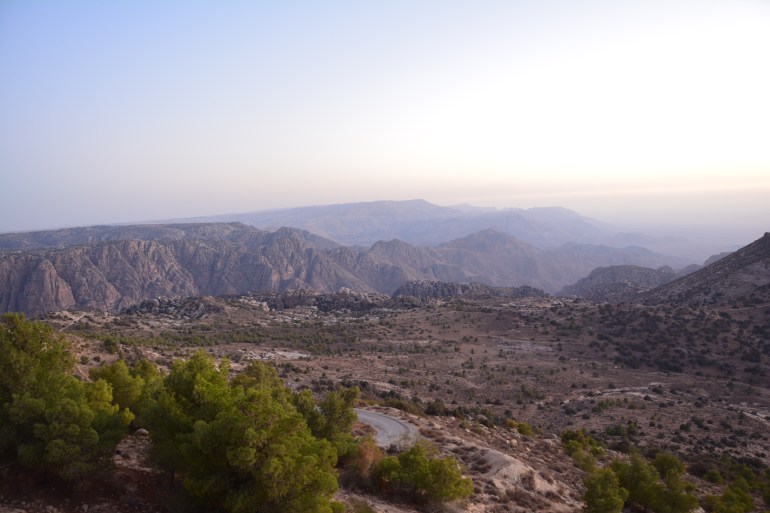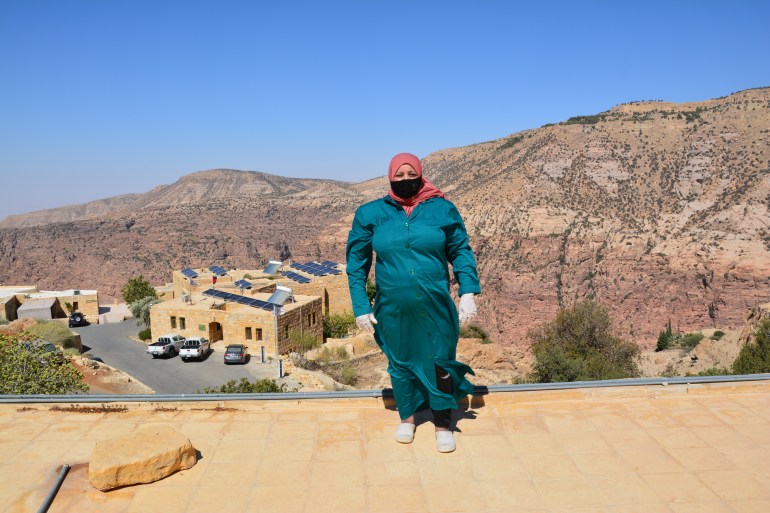Copper mine threatens Jordan’s largest nature reserve
Amman plans to mine in the Dana Biosphere Reserve, the country’s largest and most diverse protected region.

Dana, Jordan – At dawn, blue and pink rays start to break over Dana’s mountain ridges. Birdsong and rustling leaves are the only sounds in the valley.
Spread over 300sq km (116sq miles) from towering sandstone cliffs to desert plains, the Dana Biosphere Reserve is Jordan’s largest and most diverse protected region but its days of quiet and natural beauty may be numbered.
Keep reading
list of 4 itemsJordan’s Crown Prince Hussein contracts COVID
Drought diplomacy boosts Israel-Jordan ties
Syrian military chief makes rare visit to Jordan
The Jordanian government, claiming there are an estimated 45 million tonnes of copper in Dana, says it’s going to mine in the area.
The prospect of seeing his beloved hills blasted to extract copper and the valleys turned into a mound of waste rock fills Abdulrahman Ammarin with dread.
“The excavations will ruin the area we were protecting for so many years,” he told Al Jazeera.
For the past 20 years, he has worked as a ranger with the Royal Society for the Conservation of Nature (RSCN), a non-governmental organisation running Jordan’s reserves. But his Bedouin tribe has guarded this rugged landscape for centuries.
Ammarin, who lives near the reserve, worries not only about the irreversible damage the mining might cause to his region, but also the impact it could have on his family and community. “The pollution will affect all of us,” he says.
Pointing to a nearby desert acacia, Jibril Ammarin, also a ranger from the region, starts listing the diverse types of trees and vegetation that can be found in the reserve. “We have junipers, oak and pistachio trees, date palms,” he says.
Established in 1989, the reserve is home to more than 800 different species of plants and 215 species of birds, representing about one-third of Jordan’s plant species and half of all the bird species. Some are considered threatened and a few of them can only be found in Dana.
The rangers say a mining project would destroy the land, drive away animals, and could contaminate the water and soil.

Widespread criticism
In August, the government tasked the environment ministry with carving out a portion of the reserve to allow copper prospection and extraction on – and to form a committee to look for new land to replace the areas that would be mined.
The exact area to be expropriated, said to range anywhere between 60 to 106 sq km, is still under negotiation but the plan has sparked outrage and has been heavily criticised by conservationists and environmental activists.
RSCN condemned the government’s decision, rejecting any modification to the reserve’s boundaries, and saying it would take all legal measures to protect it.
“It’s a very diverse area with four different bio-geographic zones, and it also has important archaeological sites. Its biodiversity and heritage need to be protected,” says Fares Khoury, a professor of animal biology and co-founder of the NGO Jordan Birdwatch.
He told Al Jazeera several threatened birds, such as the Syrian serin and the sooty falcon, depend on the reserve for survival. “The area is very sensitive. If the [mining] project goes ahead, it will leave only destruction.”
Muna Hindiyeh, a professor of environmental engineering and an expert on water management, says mining requires a lot of water and poses a serious threat to the region’s extremely scarce water resources.
“There is a great chance that heavy metals will reach groundwater and pollute it,” she says. According to Hindiyeh, mining would also increase soil erosion and result in loss of biodiversity, so she says the negative impact of the project would need to be carefully assessed.
But so far, no environmental impact studies have been made public.
“We need complete studies on the exact cost of copper extraction and the environmental impact it would have on the region,” RSCN’s chair Khaled al-Irani told Al Jazeera.
Conservationists say the numbers presented by the government are only estimates, and serious independent studies were not carried out. “There is no transparency in the process,” says Khoury.
Jordan’s ministries of environment and energy and mineral resources did not respond to Al Jazeera’s interview requests.

In addition to concerns that mining will cause irreparable environmental harm, many are also worried about how it could affect the area’s archaeological sites that span from the Palaeolithic to Roman and Islamic periods.
The reserve is under consideration for UNESCO World Heritage site status, a position that experts worry will be threatened by the mining project. Jordan’s International Council on Monuments and Sites (ICOMOS) said the decision to open the reserve “for intrusive and destructive mining investments is short-sighted, ill-advised and sets a dangerous precedent”.
Concerned Jordanians have also launched online petitions and have flooded social media with the hashtag #Save_Dana.
Economic development vs sustainability
Despite the public outcry, the government has defended the mining project, arguing it would create 1,000 jobs and bring investment to the region, especially since demand for copper is increasing exponentially.
In 2016, the government gave the Jordanian Integrated Mining and Exploration Company a licence to mine for copper in the reserve. The company is owned by Manaseer, a group with investments in oil, gas and mining, and by the Jordanian military.
According to Manaseer, the mining project would “support the national economy” and create job opportunities in a country where unemployment rates have reached an alarming rate of 25 percent. Tafila, the southern governorate where Dana is located, has been particularly hard-hit by poverty and unemployment.

At a government-organised press tour to parts of the reserve, Manaseer spokesperson Samer Makharmeh said the mine would not affect the environment.
“What environment? There are no animals, there are no trees, nothing at all here,” he said, gesturing towards a rocky part of the reserve, which also contains archaeological ruins.
“The sad thing is that they [Manaseer officials] can’t see,” says Mohammad Asfour, a campaigner for environmental protection and expert on green economy. “They can’t see the beauty, they can’t see the wildlife. They see nothing but short-term profit.”
The mine would be open for about 20 years but would leave behind a scarred landscape that could take centuries to recover.
“It’s more important to focus on sustainable solutions, not mega-projects that benefit only a few,” says Asfour. Since most of the mining jobs offered would be low-paid and short-lived, Asfour argues tourism would be a better investment, and the economic benefits of mining would be outweighed by its negative impact.
Praised as an example of sustainable development and conservation, and recognised internationally with ecotourism awards – including being in Time magazine’s list of the world’s 100 greatest places – Dana attracted 80,000 visitors a year before the pandemic.
The reserve is staffed and managed by people from the region. According to RSCN, it provides about $3m annually to the local community and employs 85 local people in different sustainable tourism projects across Dana.

Ghazia al-Khasaba is one of more than a dozen women employed by RSCN in Dana’s production of jams, herbal infusions, candles and handmade crafts.
“I’ve been working here for 24 years to support my sick husband and my daughter,” she says, adding that her job at the reserve is her family’s only source of income.
“If the mining project goes ahead it will affect tourism here, so it will affect my source of income,” she adds.
Outside the reserve and the region’s main touristic attractions, however, residents are split over the copper mine. While many say the environmental damage is too great a risk, others welcome the job opportunities the mining industry could offer them.
Musa al-Saedeen, who is from the nearby town of al-Qraiqreh and works in the public sector, acknowledges the value of the reserve and the benefits it brought to local communities but says work opportunities in the region remain limited.
“For the people who are not benefitting from tourism, it’s their right to demand jobs and better opportunities,” he says.
But for al-Khasaba, what is at stake goes beyond her job. Her house and agricultural land are so close to the planned mining site she worries about the noise, the dust and the pollution. And beyond that, she worries about the next generations.
“[The mine] will affect our future, and our children’s future,” she says.
